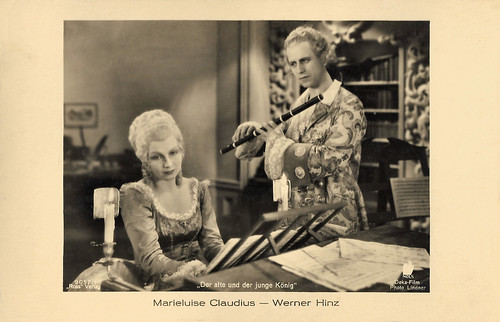
German postcard by Film-Foto-Verlag, no. A 3869/1, 1941-1944. Photo: Wesel / Berlin-Film.

German postcard by Ross Verlag, no. 9052/1, 1935-1936. Photo: Lindner / Deka-Film / NDLS. Marieluise Claudius and Werner Hinz in Der alte und der junge König / The Making of a King (Hans Steinhoff, 1935).

German postcard by Ross Verlag, no. A 3284/1, 1941-1944. Photo: Binz / Tobis.
A man without qualities, who had all the qualities at his disposal
Werner Heinz Alfons Hinz was born in 1903 in Berlin in the German Empire. His parents were the authorised signatory Oskar Hinz and his wife Hedwig Hinz, née Abel. He studied drama in his home town, at the school created by Max Reinhardt as part of the Deutsches Theater. He made his stage debut in 1922, in Frank Wedekind's 'Frühlings Erwachen' (Spring Awakening).
Throughout his career, he remained active in the theatre. He played at the Hamburg Kammerspiele in 1924/1925, at the Schauspielhaus Zürich in 1928/1929, in Darmstadt from 1929 to 1932, at the Deutsches Schauspielhaus Hamburg from 1932 to 1939 and at the Volksbühne Berlin from 1939 to 1944, before returning to the Deutsches Theater from 1947 to 1950. He had a wide range of roles at his disposal, Georg Hensel described him in his obituary in 1985 as a ‘man without qualities, who had all the qualities at his disposal.’
Werner Hinz made his first film appearance in 1929 in the Swiss short film Hallo Switzerland! In 1935, he made his actual film debut opposite Emil Jannings in the Prussian film Der alte und der junge König / The Old and the Young King (Hans Steinhoff, 1935). The film is a historical drama about the intense conflict between Prussian King Friedrich Wilhelm I and his son and heir, Crown Prince Friedrich (Hinz) – the future King Friedrich II "The Great".
Between 1935 and 1945, Hinz had roles in 17 films that were mostly praised by Joseph Goebbels, the head of the Ministry of Public Enlightenment and Propaganda. He appeared in the anti-Soviet propaganda film Weisse Sklaven / White Slaves (Karl Anton, 1937). The film, also known as Panzerkreuzer Sebastopol: Weisse Sklaven / Battleship Sevastopol: White Slaves, was designed as a response to Sergei Eisenstein's Bronenosets Potyomkin / Battleship Potemkin (1925).
He also appeared in the anti-British propaganda dramas Der Fuchs von Glenarvon / The Fox of Glenarvon (Max W. Kimmich, 1940), portraying the Irish fight for independence during World War I, and Mein Leben für Irland / My Life for Ireland (Max W. Kimmich, 1941). Another propaganda film attacking the United Kingdom was the German biographical film Ohm Krüger / Uncle Krüger (Hans Steinhoff, 1941) starring Emil Jannings as the South African politician Paul Kruger, who was eventually defeated by the British during the Boer War. In 1944, Werner Hinz was included on the Gottbegnadeten list (list of artists considered crucial to National Socialist culture) created by Goebbels.

German postcard by Ross Verlag, no. 200/2. Photo: Lindner / Deka-Film. Werner Hinz in Der alte und der junge König / The Old and the Young King (Hans Steinhoff, 1935).

German postcard by Ross Verlag, no. A 3318/1, 1941-1944. Photo: Binz / Tobis.
Regularly serious and sometimes arrogant or calculating characters
After the war, Werner Hinz continued his career in the German cinema. A notable exception was his contribution to the American War film The Longest Day (Ken Annakin, a.o., 1962), starring John Wayne and Henry Fonda. Hinz played Erwin Rommel.
His other post-war films included Feuerwerk / Fireworks (Kurt Hoffmann, 1954), with Lilli Palmer and Romy Schneider, and Bekenntnisse des Hochstaplers Felix Krull / The Confessions of Felix Krull (Kurt Hoffmann, 1957), with Horst Buchholz and Liselotte Pulver.
Hinz's characters are regularly serious and sometimes arrogant, such as Kaiser Wilhelm in Die Entlassung / The Dismissal (Wolfgang Liebeneiner, 1942), calculating, such as Zaharoff in Herz der Welt / No Greater Love (Harald Braun, 1952), dignified, such as Consul Buddenbrook in Buddenbrooks (Alfred Weidenmann, 1959), and repeatedly military, such as Colonel General Beck in Der 20. Juli / The Plot to Assassinate Hitler (Falk Harnack, 1955).
Between 1960 and 1985, Werner Hinz appeared in twenty-seven TV films. He also acted in eight series, including episodes of the popular Krimis Tatort / Crime Scene (1971), Der Kommissar / The Commissioner (1974) and Derrick (1977).
Hinz's first marriage was to the writer and translator Ilona Koenig in 1926, and after their divorce in 1934, to the actress Ehmi Bessel. Their two children, Knut and Michael, also became actors. Their daughter Dinah, who came from a relationship between Ehmi and the aviator general Ernst Udet, also became an actress. Werner Hinz died in 1985 in Hamburg, West Germany. He was 82. He is buried in Berlin's Dahlem cemetery.

East German postcard by Deutscher Filmverlag G.m.b.H., Berlin, no. 105. Photo: DEFA / Neufeld. Photo: Werner Hinz in Die Buntkarierten / The Girls in Gingham (Kurt Maetzig, 1949).

West-German postcard by Ufa/Film-Foto, Berlin-Tempelhof, no. FK 1087. Photo: Lilo / NDF Film / Schorcht Film. Werner Hinz in Feuerwerk / Fireworks (Kurt Hoffmann, 1954).

West-German postcard by Ufa/Film-Foto. Photo: Lilo / NDF Film / Schorcht Film. Werner Hinz in Der letzte Sommer / The Last Summer (Harald Braun, 1954).
Sources: Wikipedia (English and German) and IMDb.
No comments:
Post a Comment